2013 Hyundai Equus sensor
[x] Cancel search: sensorPage 10 of 479

13
Introduction
Gasoline engine
Unleaded
For Europe
For the optimal vehicle performance,
we recommend you use unleaded
gasoline which has an octane rating
of RON (Research Octane Number)
95 / AKI (Anti Knock Index) 91 or
higher. (Do not use methanol blend-
ed fuels.)
You may use unleaded gasoline with
an octane rating of RON 91~94/AKI
87~90 but it may result in slight per-
formance reduction of the vehicle.
Except Europe
Your new Hyundai vehicle is
designed to use only unleaded fuel
having an Octane Rating of RON
(Research Octane Number) 91 / AKI
(Anti-Knock Index) 87 or higher. (Do
not use methanol blended fuels.)
Your new vehicle is designed to
obtain maximum performance with
UNLEADED FUEL, as well as mini-
mize exhaust emissions and spark
plug fouling.
FUEL REQUIREMENTS
WARNING
• Do not "top off" after the noz-
zle automatically shuts off
when refueling.
• Always check that the fuel cap
is installed securely to pre-
vent fuel spillage in the event
of an accident.
CAUTION
NEVER USE LEADED FUEL. The
use of leaded fuel is detrimental
to the catalytic converter and
will damage the engine control
system’s oxygen sensor and
affect emission control.
Never add any fuel system
cleaning agents to the fuel tank
other than what has been speci-
fied. (Consult an authorized
HYUNDAI dealer for details.)
Page 54 of 479

335
Safety features of your vehicle
✽NOTICE
Because the sensor that activates the
SRS air bag is connected with the
pre-tensioner seat belt, the SRS air
bag warning light on the instru-
ment panel will illuminate for
approximately 6 seconds after the
ignition switch has been turned to
the ON position, and then it should
turn off.
CAUTION
If the pre-tensioner seat belt is
not working properly, this warn-
ing light will illuminate even if
there is no malfunction of the
SRS air bag. If the SRS air bag
warning light does not illumi-
nate when the ignition switch is
turned to ON, or if it remains
illuminated after illuminating for
approximately 6 seconds, or if it
illuminates while the vehicle is
being driven, we recommend
that the system be inspected by
an authorized HYUNDAI dealer.
WARNING
• Pre-tensioners are designed
to operate only one time. After
activation, pre-tensioner seat
belts must be replaced. All
seat belts, of any type, should
always be replaced after they
have been worn during a colli-
sion.
• The pre-tensioner seat belt
assembly mechanisms become
hot during activation. Do not
touch the pre-tensioner seat
belt assemblies for several
minutes after they have been
activated.
• Do not attempt to inspect or
replace the pre-tensioner seat
belts yourself. We recommend
that the system be inspected
by an authorized HYUNDAI
dealer.
• Do not strike the pre-tension-
er seat belt assemblies.
• Do not attempt to service or
repair the pre-tensioner seat
belt system in any manner.
(Continued)
(Continued)
• Improper handling of the pre-
tensioner seat belt assem-
blies, and failure to heed the
warnings not to strike, modify,
inspect, replace, service or
repair the pre-tensioner seat
belt assemblies may lead to
improper operation or inad-
vertent activation and serious
injury.
• Always wear the seat belts
when driving or riding in a
motor vehicle.
• If the vehicle or pre-tensioner
seat belt must be discarded,
we recommend that you con-
tact an authorized HYUNDAI
dealer.
CAUTION
Body work on the front area of
the vehicle may damage the pre-
tensioner seat belt system.
Therefore, we recommend that
the system be serviced by an
authorized HYUNDAI dealer.
Page 70 of 479

351
Safety features of your vehicle
How does the air bag system
operate
• Air bags are activated (able to
inflate if necessary) only when the
engine start/stop button is turned
to the ON or START position.
• Air bags inflate instantly in the
event of a serious frontal collision
or side collision in order to help
protect the occupants from serious
physical injury.
• There is no single speed at which
the air bags will inflate.
Generally, air bags are designed to
inflate based upon the severity of a
collision and its direction. These
two factors determine whether the
sensors produce an electronic
deployment/ inflation signal.
• Air bag deployment depends on a
number of factors including vehicle
speed, angles of impact and the
density and stiffness of the vehi-
cles or objects which your vehicle
hits in the collision. The determin-
ing factors are not limited to those
mentioned above.• The front air bags will completely
inflate and deflate in an instant.
It is virtually impossible for you to
see the air bags inflate during an
accident.
It is much more likely that you will
simply see the deflated air bags
hanging out of their storage com-
partments after the collision.
• In order to help provide protection
in a severe collision, the air bags
must inflate rapidly. The speed of
air bag inflation is a consequence
of the extremely short time in which
a collision occurs and the need to
inflate the air bag between the
occupant and the vehicle structures
before the occupant impacts those
structures. This speed of inflation
reduces the risk of serious or life-
threatening injuries in a severe col-
lision and is thus a necessary part
of air bag design.
However, air bag inflation can also
cause injuries which can include
facial abrasions, bruises and bro-
ken bones because the inflation
speed also causes the air bags to
expand with a great deal of force.• There are even circumstances
under which contact with the
steering wheel air bag can cause
fatal injuries, especially if the
occupant is positioned exces-
sively close to the steering wheel.
WARNING
• To avoid severe personal
injury or death caused by
deploying air bags in a colli-
sion, the driver should sit as
far back from the steering
wheel air bag as possible (at
least 250 mm (10 inches)
away). The front passengers
should always move their
seats as far back as possible
and sit back in their seat.
• Air bags inflate instantly in the
event of collision, and passen-
gers may be injured by the air
bag expansion force if they are
not in a proper position.
• Air bag inflation may cause
injuries including facial or
bodily abrasions, injuries
from broken glasses or burns.
Page 73 of 479
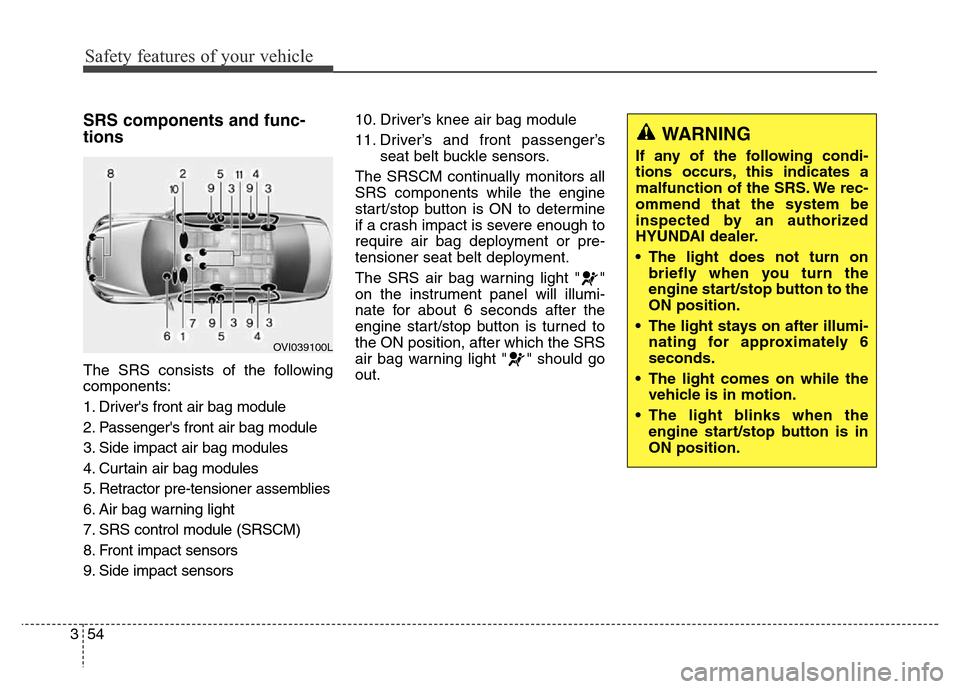
Safety features of your vehicle
54 3
SRS components and func-
tions
The SRS consists of the following
components:
1. Driver's front air bag module
2. Passenger's front air bag module
3. Side impact air bag modules
4. Curtain air bag modules
5. Retractor pre-tensioner assemblies
6. Air bag warning light
7. SRS control module (SRSCM)
8. Front impact sensors
9. Side impact sensors10. Driver’s knee air bag module
11. Driver’s and front passenger’s
seat belt buckle sensors.
The SRSCM continually monitors all
SRS components while the engine
start/stop button is ON to determine
if a crash impact is severe enough to
require air bag deployment or pre-
tensioner seat belt deployment.
The SRS air bag warning light " "
on the instrument panel will illumi-
nate for about 6 seconds after the
engine start/stop button is turned to
the ON position, after which the SRS
air bag warning light " " should go
out.
OVI039100L
WARNING
If any of the following condi-
tions occurs, this indicates a
malfunction of the SRS. We rec-
ommend that the system be
inspected by an authorized
HYUNDAI dealer.
• The light does not turn on
briefly when you turn the
engine start/stop button to the
ON position.
• The light stays on after illumi-
nating for approximately 6
seconds.
• The light comes on while the
vehicle is in motion.
• The light blinks when the
engine start/stop button is in
ON position.
Page 77 of 479
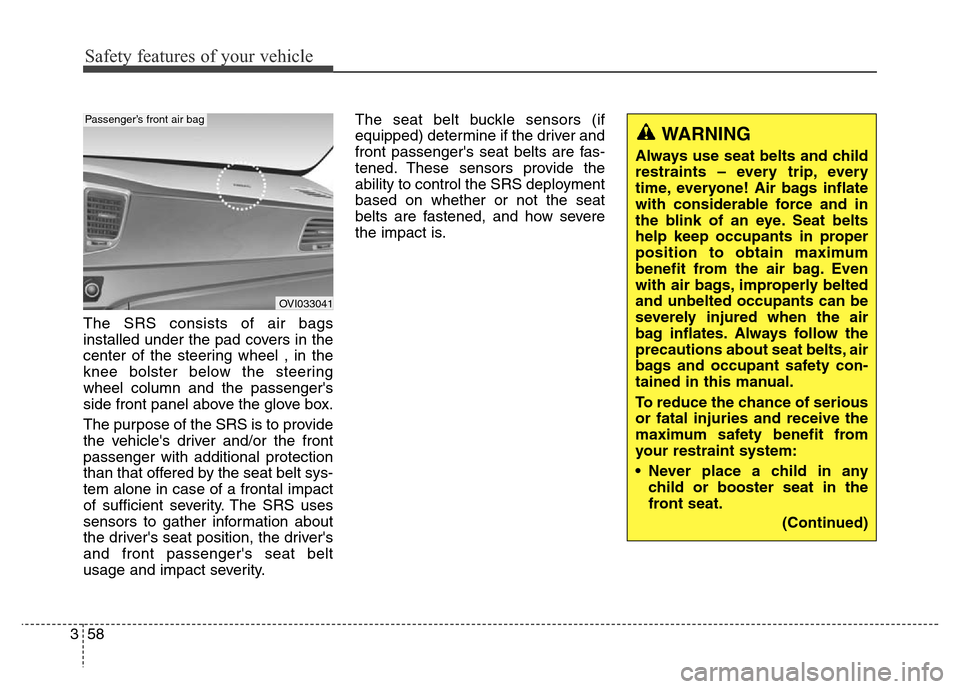
Safety features of your vehicle
58 3
The SRS consists of air bags
installed under the pad covers in the
center of the steering wheel , in the
knee bolster below the steering
wheel column and the passenger's
side front panel above the glove box.
The purpose of the SRS is to provide
the vehicle's driver and/or the front
passenger with additional protection
than that offered by the seat belt sys-
tem alone in case of a frontal impact
of sufficient severity. The SRS uses
sensors to gather information about
the driver's seat position, the driver's
and front passenger's seat belt
usage and impact severity.The seat belt buckle sensors (if
equipped) determine if the driver and
front passenger's seat belts are fas-
tened. These sensors provide the
ability to control the SRS deployment
based on whether or not the seat
belts are fastened, and how severe
the impact is.
OVI033041
Passenger’s front air bag
WARNING
Always use seat belts and child
restraints – every trip, every
time, everyone! Air bags inflate
with considerable force and in
the blink of an eye. Seat belts
help keep occupants in proper
position to obtain maximum
benefit from the air bag. Even
with air bags, improperly belted
and unbelted occupants can be
severely injured when the air
bag inflates. Always follow the
precautions about seat belts, air
bags and occupant safety con-
tained in this manual.
To reduce the chance of serious
or fatal injuries and receive the
maximum safety benefit from
your restraint system:
• Never place a child in any
child or booster seat in the
front seat.
(Continued)
Page 80 of 479
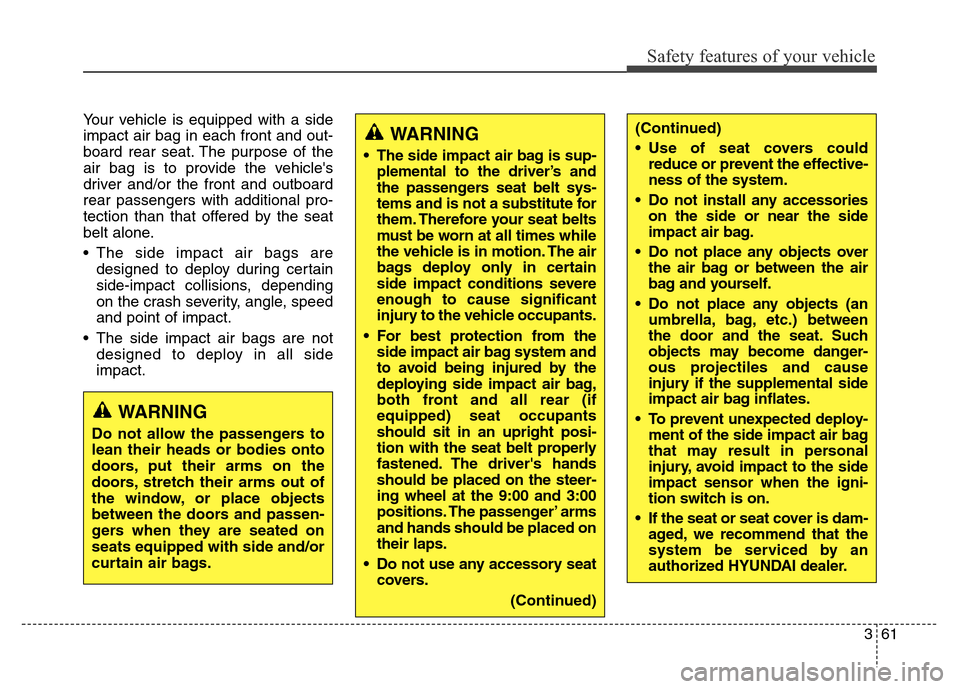
361
Safety features of your vehicle
Your vehicle is equipped with a side
impact air bag in each front and out-
board rear seat. The purpose of the
air bag is to provide the vehicle's
driver and/or the front and outboard
rear passengers with additional pro-
tection than that offered by the seat
belt alone.
• The side impact air bags are
designed to deploy during certain
side-impact collisions, depending
on the crash severity, angle, speed
and point of impact.
• The side impact air bags are not
designed to deploy in all side
impact.
WARNING
• The side impact air bag is sup-
plemental to the driver’s and
the passengers seat belt sys-
tems and is not a substitute for
them. Therefore your seat belts
must be worn at all times while
the vehicle is in motion. The air
bags deploy only in certain
side impact conditions severe
enough to cause significant
injury to the vehicle occupants.
• For best protection from the
side impact air bag system and
to avoid being injured by the
deploying side impact air bag,
both front and all rear (if
equipped) seat occupants
should sit in an upright posi-
tion with the seat belt properly
fastened. The driver's hands
should be placed on the steer-
ing wheel at the 9:00 and 3:00
positions. The passenger’ arms
and hands should be placed on
their laps.
• Do not use any accessory seat
covers.
(Continued)
WARNING
Do not allow the passengers to
lean their heads or bodies onto
doors, put their arms on the
doors, stretch their arms out of
the window, or place objects
between the doors and passen-
gers when they are seated on
seats equipped with side and/or
curtain air bags.
(Continued)
• Use of seat covers could
reduce or prevent the effective-
ness of the system.
• Do not install any accessories
on the side or near the side
impact air bag.
• Do not place any objects over
the air bag or between the air
bag and yourself.
• Do not place any objects (an
umbrella, bag, etc.) between
the door and the seat. Such
objects may become danger-
ous projectiles and cause
injury if the supplemental side
impact air bag inflates.
• To prevent unexpected deploy-
ment of the side impact air bag
that may result in personal
injury, avoid impact to the side
impact sensor when the igni-
tion switch is on.
• If the seat or seat cover is dam-
aged, we recommend that the
system be serviced by an
authorized HYUNDAI dealer.
Page 82 of 479
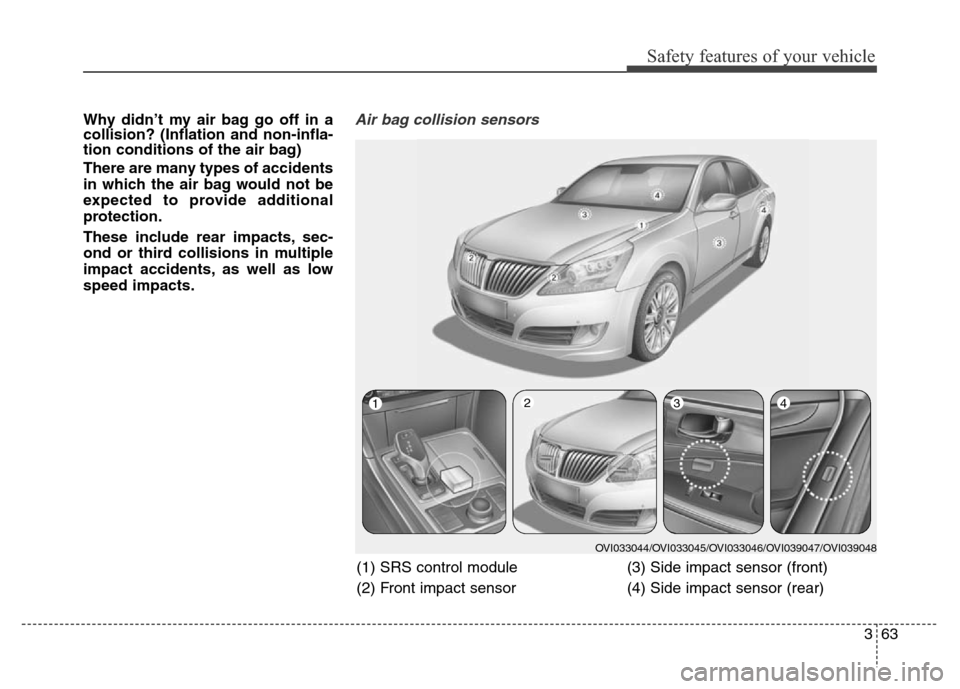
363
Safety features of your vehicle
Why didn’t my air bag go off in a
collision? (Inflation and non-infla-
tion conditions of the air bag)
There are many types of accidents
in which the air bag would not be
expected to provide additional
protection.
These include rear impacts, sec-
ond or third collisions in multiple
impact accidents, as well as low
speed impacts.Air bag collision sensors
OVI033044/OVI033045/OVI033046/OVI039047/OVI039048
1234
(1) SRS control module
(2) Front impact sensor(3) Side impact sensor (front)
(4) Side impact sensor (rear)
Page 83 of 479
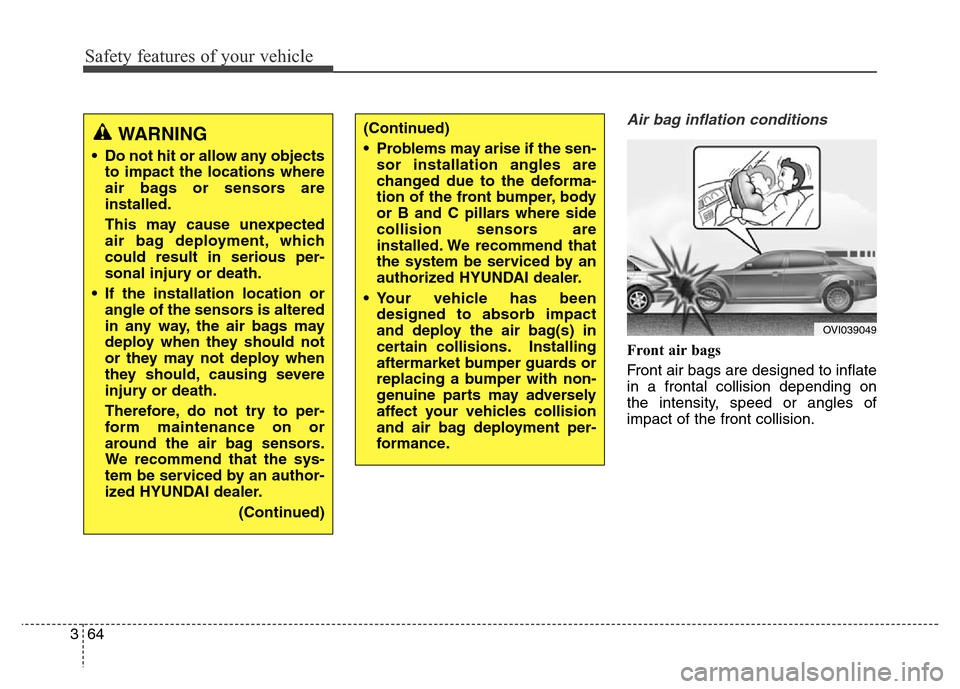
Safety features of your vehicle
64 3
Air bag inflation conditions
Front air bags
Front air bags are designed to inflate
in a frontal collision depending on
the intensity, speed or angles of
impact of the front collision.
OVI039049
(Continued)
• Problems may arise if the sen-
sor installation angles are
changed due to the deforma-
tion of the front bumper, body
or B and C pillars where side
collision sensors are
installed. We recommend that
the system be serviced by an
authorized HYUNDAI dealer.
• Your vehicle has been
designed to absorb impact
and deploy the air bag(s) in
certain collisions. Installing
aftermarket bumper guards or
replacing a bumper with non-
genuine parts may adversely
affect your vehicles collision
and air bag deployment per-
formance.WARNING
• Do not hit or allow any objects
to impact the locations where
air bags or sensors are
installed.
This may cause unexpected
air bag deployment, which
could result in serious per-
sonal injury or death.
• If the installation location or
angle of the sensors is altered
in any way, the air bags may
deploy when they should not
or they may not deploy when
they should, causing severe
injury or death.
Therefore, do not try to per-
form maintenance on or
around the air bag sensors.
We recommend that the sys-
tem be serviced by an author-
ized HYUNDAI dealer.
(Continued)